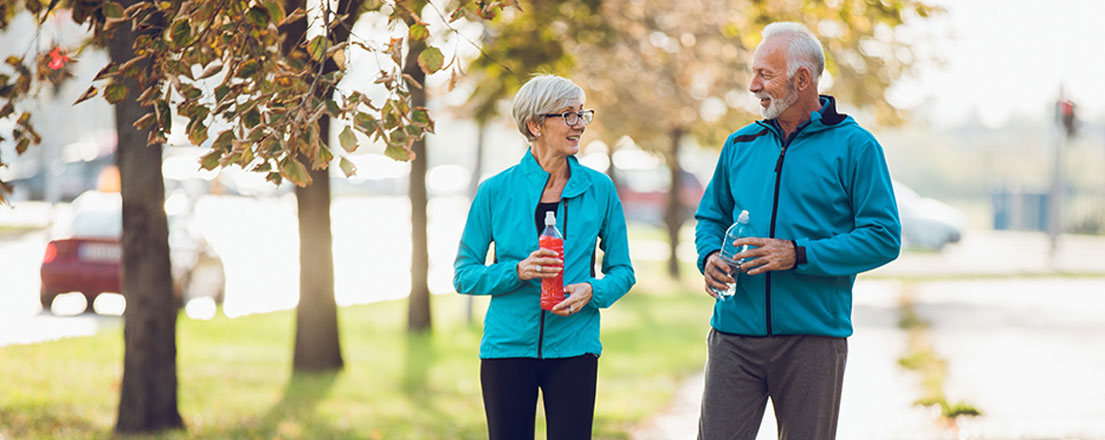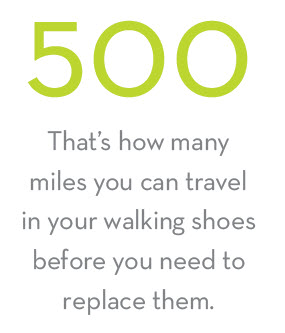
Walk This Way: Here’s How to Get Moving
Walking is one of the very first milestones we hit as children. And now science is discovering how much walking can help us maintain better mental, emotional and physical health through adulthood.
Consider this: Walking improves blood flow to the brain, which may improve brain function. Brisk walking for an hour a day helps battle the effect of genes tied to obesity. And women who walk may have a lower risk of breast cancer.
So, how do you get in more steps? And how many steps, exactly, should you get? Read on for expert advice on how to walk your way to better health.
How many steps should you walk?
Many people focus on 10,000 steps, but that number isn’t an official recommendation; the Centers for Disease Control and Prevention instead suggests at least 150 minutes a week of moderate-intensity physical activity. That can be done in 10-minute episodes throughout the week, says Dr. Elizabeth Matzkin, surgical director, Chief of Women’s Sports Medicine at Brigham and Women’s Hospital in Boston. “One does not have to go for a 30- or 60-minute walk to make it beneficial,” she says. Unfortunately, she adds, “almost one-half of all adults and one-fourth of high school students do not meet the minimal guidelines of physical activity.”
Should you track it? If it helps with goal setting, absolutely – whatever gets you moving.
![]() You can sync your activity tracker with iStrive for Better Health and join us in step challenges, 5K training and more. iStrive is compatible with more than 140 fitness trackers. Log in to hap.org and click on “iStrive for Better Health” to get started.
You can sync your activity tracker with iStrive for Better Health and join us in step challenges, 5K training and more. iStrive is compatible with more than 140 fitness trackers. Log in to hap.org and click on “iStrive for Better Health” to get started.
Does walking work for everyone?
Generally, yes – even people with bone or joint issues. “Walking is a very good exercise that’s fairly low impact and gets a lot of muscles and joints moving,” says Dr. David Geier, a South Carolina-based orthopedic surgeon, sports medicine specialist and author. “And if you do it at a halfway decent speed, you can increase heart rate and get a good workout. We want people to exercise and have them healthy and in shape.”
As with any exercise, you should discuss walking with your health care provider and increase your activity level gradually. “The biggest points to remember about motivation and preventing injury are to work into it slowly – to not push distance or intensity right out of the gate,” Dr. Geier says. “I recommend starting with way less than you can do until it becomes a habit.” Use the running rule: Increase your mileage 10 percent a week until you reach your goal. Also consider walking every second or third day to give joints a rest, Dr. Geier says.
Don’t forget the shoes and the route
 Shoes don’t need lots of bells and whistles, but they do need to provide good support. In addition, find routes that are safe and accessible, with sidewalks and lighting. “If you are looking to evaluate the safety of a walk or area for walking, consider grabbing a neighbor or friend to do a walking audit,” says Heidi Simon, partnerships and communications director, America Walks, a national nonprofit dedicated to promoting walking. “It’s a great way to get active and find ways to get involved with how your community is shaped.”
Shoes don’t need lots of bells and whistles, but they do need to provide good support. In addition, find routes that are safe and accessible, with sidewalks and lighting. “If you are looking to evaluate the safety of a walk or area for walking, consider grabbing a neighbor or friend to do a walking audit,” says Heidi Simon, partnerships and communications director, America Walks, a national nonprofit dedicated to promoting walking. “It’s a great way to get active and find ways to get involved with how your community is shaped.”
“But walking is boring …”
It doesn’t have to be. There are lots of ways to challenge your body and get more from a walk – even if it’s just 10 minutes:
- Walk in the shallow end of a pool. “Water takes away all of the gravity and stress on hips and knees,” Dr. Geier says.
- Turn walking into a high-intensity training workout. “We associate walking as this leisurely, steady-state thing,” Dr. Geier says. “It doesn’t have to be that way.” Try going one minute superfast and one minute slowly, for example. Or ramp up the incline on a treadmill and go for short bursts – say 30 seconds – and alternate it with fast but flat walking.
- Add stairs or hills. If knees are an issue, stairs might be difficult. But hills and stairs are great to incorporate into walking to build strength and change intensity.
- Do one errand a week as a walk. Consider ways to make your days more active – even if it’s just a walk to the store to replenish your home’s milk supply, or parking in a spot farther away from a store’s entrance. Or schedule a walking meeting at work, Simon says.
Check out related post:
Sitting All Day? Get Moving Instead
Find out how sitting too much is harmful to your health and what you can do about it
Categories: Get Moving

